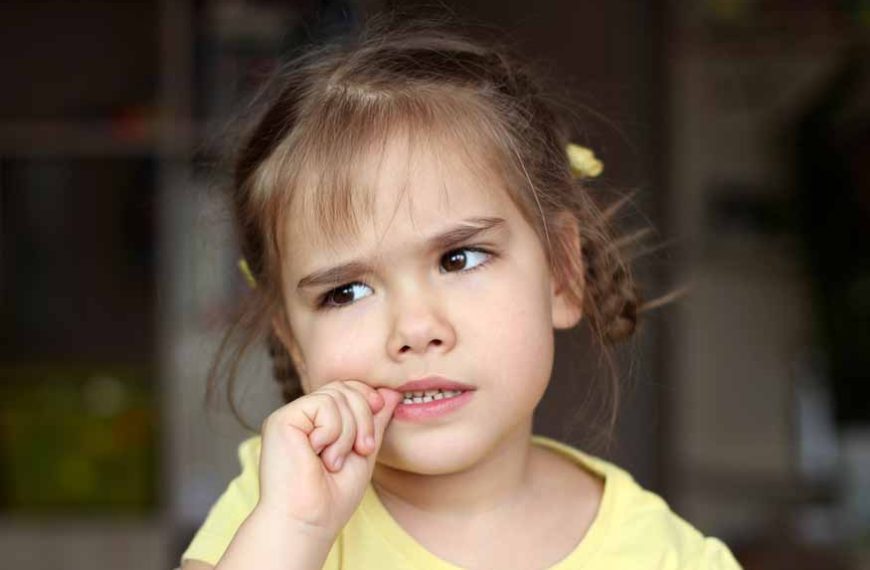Nail biting in children is a pervasive and resilient habit that doesn’t just disappear overnight. Picture this, you’re at a family gathering, and amidst the bustle and chatter, you notice your little one, engrossed in a world of their own, thumbing through a book while unconsciously nibbling at their nails. You’ve tried everything from scolding to explaining, yet this pesky habit sticks around like a bad smell.
Nail biting is clinically referred to as onychophagia. It is a stress-relieving habit most common among young children and adolescents. Unfortunately, it often carries into adulthood if not addressed early. Nail biting in children can lead to dental issues, and skin infections, and negatively impact self-esteem. Many parents wonder, “How do I stop my child from biting his nails?” or “how to stop biting nails?” In this blog, we’ll examine eight distinct methods for stopping nail biting that we hope will help you teach your kids healthy habits.
Why Do Kids Bite Their Nails? – The Hidden Cause Behind Your Child’s Nail-Biting Habit
Do you know the root cause for nail biting in kids?
Nail biting in children is often a sign of emotional or psychological stress. It’s a self-soothing behaviours that kids resort to when they feel anxious, nervous, or simply bored. Stressors could range from a new environment, such as a new school or classroom, to family issues or academic pressure. Additionally, some children might pick up the habit from observing others around them, like parents or siblings, who bite their nails. Moreover, child’s habit of biting nails may also be due to boredom they experience.
Why Biting Nails Is Harmful for Children?
Biting nails is not just a bad habit. Do note that nail biting can also result in a number of critical health problems. It can cause skin infections around the nail bed, as constant biting and saliva exposure can lead to bacterial and fungal infections. The habit can also lead to dental problems. Furthermore, as children’s hands carry a host of germs from everything they touch, nail biting increases the risk of them ingesting these germs, leading to illnesses. Beyond physical health, persistent nail biting can result in lower self-esteem as the child grows older and becomes more conscious of their appearance. So, what do you do when you see a child nail biting?
8 Tried and Tested Methods to Stop a Child From Biting Their Nails
Here are 8 effective strategies that can help your child from biting their nails. s
- Identify and Address Stress Triggers
- Use Nail Biting Inhibitors
- Positive Reinforcement
- Habit Replacement Therapy
- Use of Nail Art or Manicures
- Educate about the Health Risks
- Set a Good Example
- Mindfulness and Relaxation Techniques
Every behaviour, including nail biting, has a cause. For many children, nail biting is a coping mechanism for stress or anxiety. Identifying and addressing these triggers is the first step towards curbing this habit. For instance, if your child bites their nails when they’re bored, keep their hands busy with activities like play-dough modelling, painting, or puzzles.
Nail biting inhibitors, such as bitter-tasting polishes or ointments, can provide an immediate deterrent to nail biting. These products, which are safe and non-toxic, make nail biting an unpleasant experience, thereby reducing the child’s inclination to bite their nails over time. By using nail biting inhibitors you can curb child nail biting.
Did you know that positive reinforcement can curb nail biting in kids?
Positive reinforcement can be a powerful tool for behaviour modification. Reward your child when they avoid biting their nails. The reward could be something as simple as a sticker, an extra story at bedtime, or a small treat. This will motivate them to consciously avoid biting their nails.
Habit replacement therapy is a technique used in cognitive-behavioural therapy, where an undesirable habit is replaced with a more positive one. For instance, if your child bites their nails while watching TV, you could replace this habit with a stress ball or a fidget spinner.
Did you know that nail art or manicures are fun ways to curb nail biting in kids?
Children are typically fascinated by colourful and shiny things. Consider applying child-safe nail polish, nail stickers, or nail art to make their nails visually appealing. This can serve as a deterrent, as they may not want to ruin the pretty art on their nails.
Educating children about the health risks can curb a child’s nail-biting habit. Our little ones’ have an innate curiosity for the world around them. It’s important to inform kids about the possible health risks of nail biting when it comes to this behaviour. By educating them about the health risks associated with nail biting, you equip them with the understanding necessary to make informed decisions about their habits.
Did you know that child biting nails is one of the nervous habits?
Children are like sponges, absorbing everything they see and hear. That’s why setting a good example is crucial when it comes to addressing nail biting in children. It is necessary to concentrate on breaking your own nail-biting habit if you or a family member suffer from it. If they observe you biting your nails, it might be challenging to get a child to quit. In addition to quitting nail biting, it’s essential to adopt healthy nail-care practices. Show your child how to properly clean and trim their nails, emphasising the importance of maintaining good hygiene.
Teaching your child mindfulness and relaxation techniques can help curb nail-biting habits. Techniques such as deep breathing exercises, yoga, or even short guided meditation sessions for children can help manage stress, anxiety, or boredom – often the leading causes of nail biting. Regular practice can also improve focus and self-control, aiding them in becoming more aware of their nail-biting habit and consciously refraining from it.
“Endless reprimands, long lectures, yelling, and punishments won’t encourage your child to stop biting their nails. In fact, the negative attention may just make your child more determined to show you who’s the boss of those nails.”
Rhona Lewis, Carissa Stephens
Conclusion
In conclusion, while nail biting in children is common, it’s crucial to address this habit early to prevent potential health issues and foster healthier coping mechanisms. In our example from the start, instead of scolding or getting frustrated, you could use positive reinforcement when they manage to not bite their nails during reading time, or maybe use nail art to make their nails too beautiful to bite. Patience and consistent effort, coupled with a sprinkle of innovation, are key. Implementing nail biting prevention strategies can help children develop healthier habits and overcome this common behaviour. The article has also covered a crucial question ‘Why do kids bite their nails?’.
At EuroKids, we prioritise the overall well-being of your child. Our specially crafted curriculum incorporates mindfulness and relaxation techniques, allowing children to manage stress and anxiety effectively. Through activities like yoga, deep breathing exercises, and guided meditation sessions, we empower children to be more aware of their behaviors, including nail biting, and consciously make healthier choices.
For informative and accurate articles on all things related to your new born-toddler’s development, growth, health and nutrition, follow EuroKids Blogs and do check out our nationally recognized preschools – EuroKids for the first step in your kid’s educational journey!















